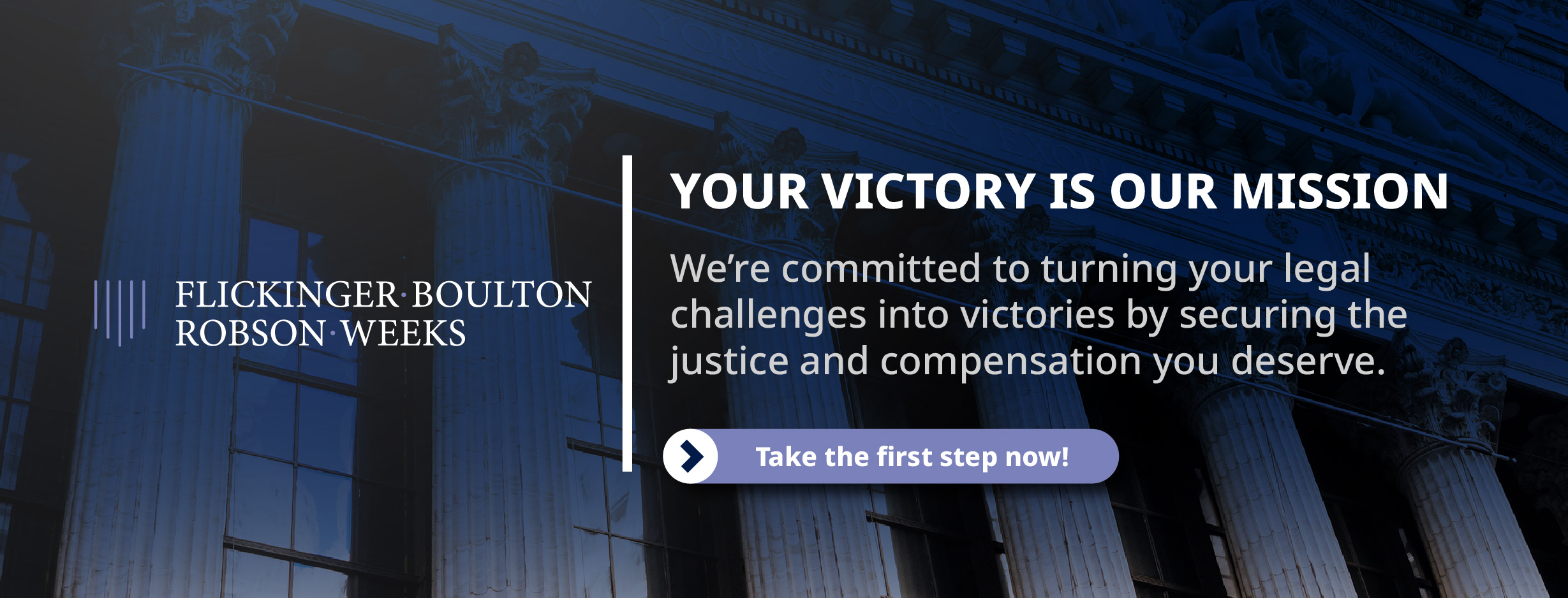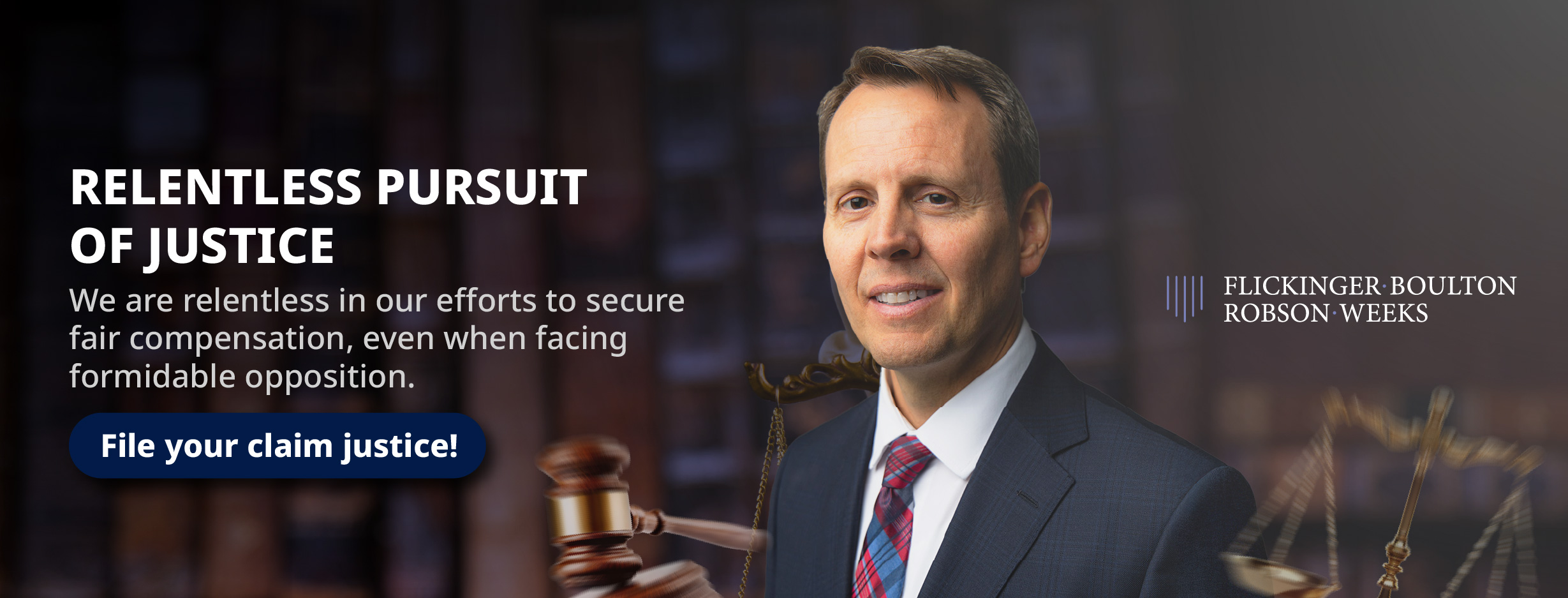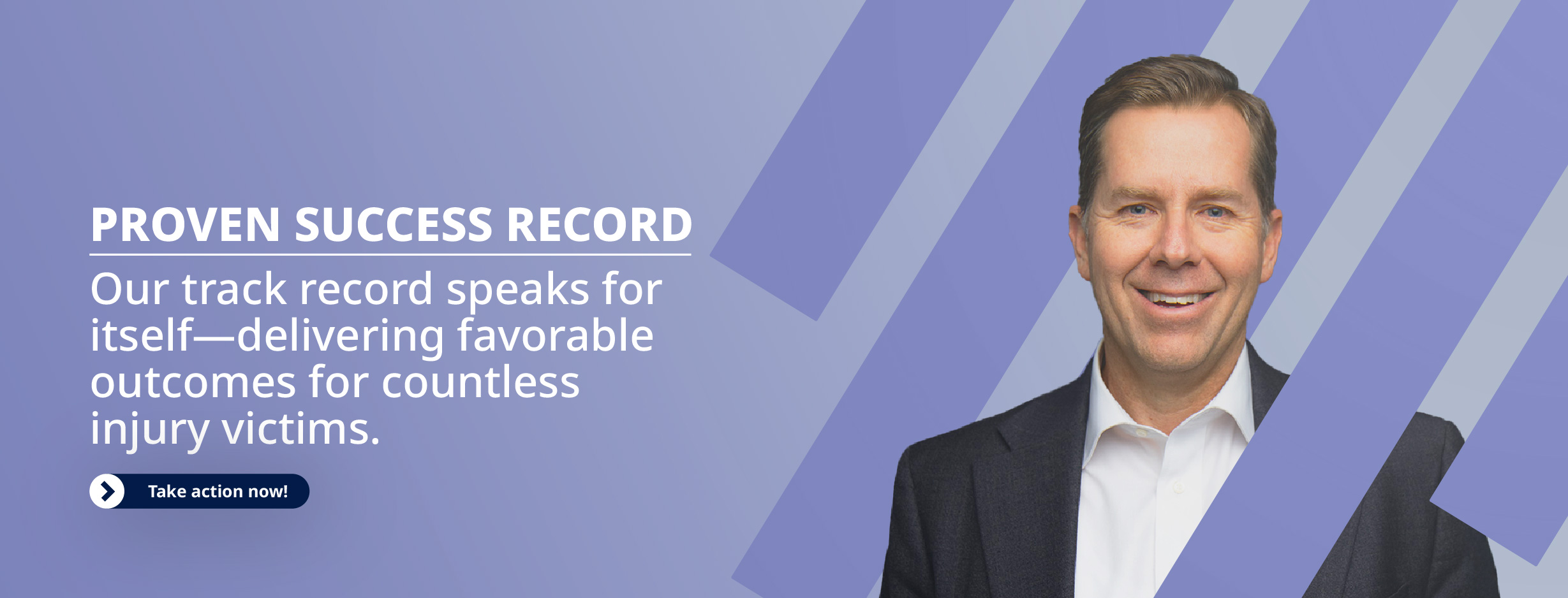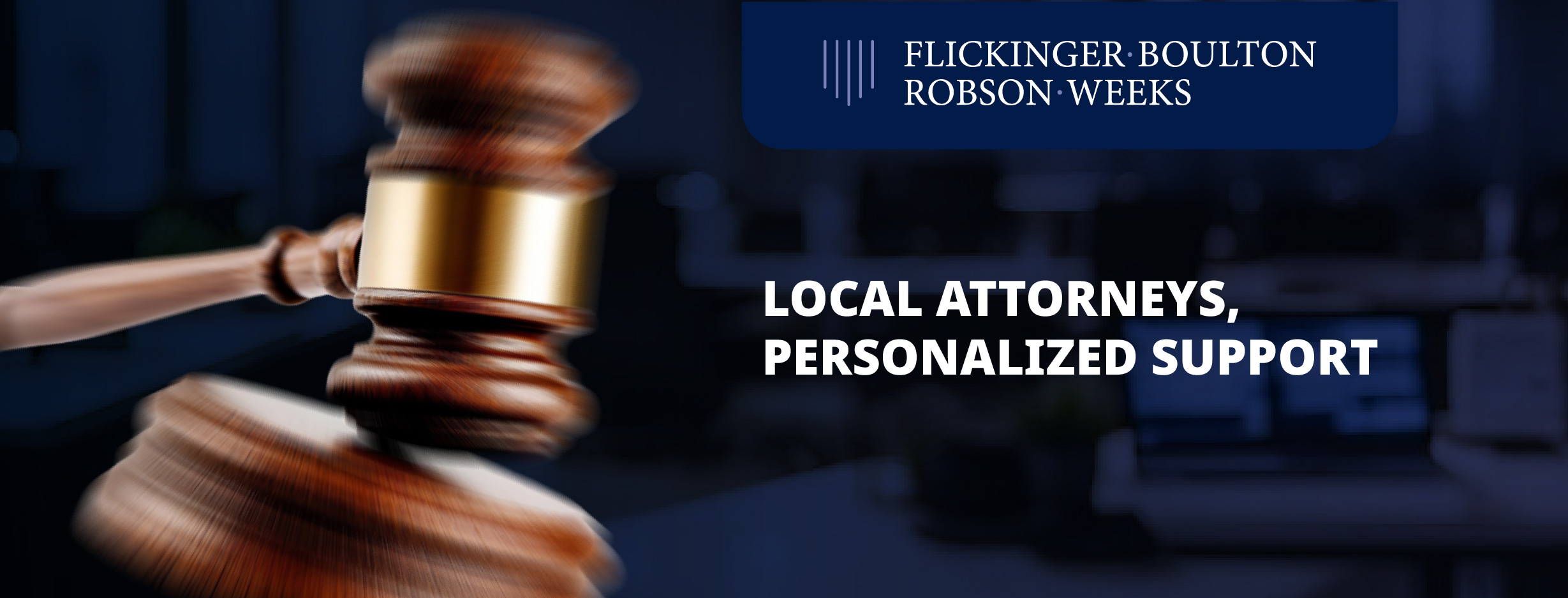Understanding the differences between personal injury lawsuits and settlements is crucial when seeking compensation after an accident in Salt Lake City. Many injury victims assume that filing a lawsuit is their only option, but in reality, most cases are resolved through settlements, often before the lawsuit is ever filed.
Each path has its own advantages and challenges, and the best approach depends on the specifics of your case. At Flickinger Boulton Robson Weeks, our experienced Salt Lake City personal injury lawyers guide clients through every stage of the legal process, whether negotiating a fair settlement or pursuing a lawsuit all the way to trial when necessary.
We are dedicated to protecting your rights and maximizing your compensation so you can focus on recovery.
When pursuing compensation for a personal injury, one of the most critical decisions you will face is whether to accept a settlement or take your case to court. Each option has its own advantages and potential drawbacks, and the right choice depends on the specifics of your case, including the severity of your injuries, the strength of the evidence, and the willingness of the insurance company to offer a fair settlement.
Most personal injury cases are resolved through settlements rather than going to trial. Settling can be advantageous because it is typically faster and less stressful than litigation. Instead of enduring a lengthy court process, you can receive compensation sooner, allowing you to cover medical bills, lost wages, and other expenses without delay. Additionally, settlements offer more predictability, as going to trial carries risks, including the possibility of losing the case entirely.
Settlements also provide privacy, as court trials become public records. If you prefer to keep details of your injuries, finances, or the incident confidential, settling may be the better option. Furthermore, legal fees and court costs can add up quickly during a trial, making a reasonable settlement a more cost-effective solution.
While settlements are often preferable, there are cases where going to trial is the better choice. If the insurance company refuses to offer fair compensation or disputes liability, filing a lawsuit may be necessary to secure the damages you deserve.
Additionally, if your injuries are severe and will require long-term medical care or have caused permanent disability, the stakes are higher, and a court award may be significantly greater than a low settlement offer.
Trials also allow for a full presentation of evidence, witness testimonies, and expert opinions, which may result in a more favorable outcome. If the other party acted with gross negligence or misconduct, a court may award punitive damages, which are typically not included in settlements.
Deciding whether to settle or go to court requires careful consideration of your case’s strengths and potential risks. Consulting with an experienced personal injury lawyer is essential in making an informed decision.
At Flickinger Boulton Robson Weeks, we carefully assess every case, negotiating aggressively for fair settlements while being fully prepared to take a case to trial if necessary. Our priority is ensuring you receive the maximum compensation for your injuries and losses.

Filing a personal injury lawsuit in Utah is a multi-step process that requires careful legal strategy and preparation. While many cases settle before reaching trial, understanding the steps involved in a lawsuit can help you navigate the process with confidence.
Below is an overview of what to expect when pursuing a personal injury claim in Utah.
The first step in a personal injury lawsuit is consulting with an experienced attorney. During this meeting, your lawyer will evaluate your case, discuss your legal options, and determine whether a lawsuit is the best course of action. They will also review evidence such as medical records, accident reports, and witness statements to assess the strength of your claim.
If negotiations with the insurance company do not result in a fair settlement, your lawyer will file a formal complaint with the court. This document outlines the details of your case, including the parties involved, the injuries sustained, and the damages being sought. Once the complaint is filed, the defendant is served with a copy and given a specific timeframe to respond.
During discovery, both sides exchange evidence and gather information to build their cases. This process may include written questions (interrogatories), depositions (sworn testimony), and requests for documents such as medical records and accident reports. Discovery allows each party to assess the strengths and weaknesses of the case before proceeding to trial.
Before going to trial, attorneys may file pre-trial motions to dismiss certain claims or limit evidence. Additionally, many cases are resolved during this phase through settlement negotiations or mediation. If a fair settlement is reached, the lawsuit is dismissed, and the plaintiff receives compensation without going to court.
If settlement negotiations fail, the case proceeds to trial. In Utah, a trial can be heard by a judge or a jury. Both sides present evidence, call witnesses, and make legal arguments. The judge or jury then determines whether the defendant is liable and, if so, how much compensation the plaintiff should receive.

If either party disagrees with the trial’s outcome, they may file an appeal, requesting a higher court to review the decision. Appeals can extend the legal process but may be necessary if errors occurred during the trial.
At Flickinger Boulton Robson Weeks, our skilled legal team guides clients through each step of a personal injury lawsuit, fighting for the compensation they deserve.
The timeline for resolving a personal injury case in Utah varies based on several factors, including the complexity of the case, the severity of the injuries, and whether the case settles or proceeds to trial.
While some cases are resolved in a few months, others can take years to conclude. Understanding the general stages of a personal injury claim can help set realistic expectations for how long your case may take.
After an accident, the first priority is medical treatment. The length of this phase depends on the severity of your injuries and how long it takes to reach maximum medical improvement. Your attorney will also begin gathering evidence, such as police reports, medical records, witness statements, and expert opinions, to build a strong case.
Most personal injury cases begin with an insurance claim. Your attorney will submit a demand letter to the insurance company outlining your damages. The insurer may respond with a settlement offer, which could lead to negotiations.
If the insurance company cooperates and offers fair compensation, the case can settle relatively quickly. However, if negotiations stall, further legal action may be necessary.
If a fair settlement cannot be reached, your attorney may file a lawsuit. Once filed, the discovery process begins, during which both sides exchange evidence and conduct depositions. Discovery can take several months, depending on the complexity of the case and court scheduling.

Before going to trial, courts often require mediation to encourage settlement. If mediation is unsuccessful, pre-trial motions and hearings take place, which can add more time to the process.
If a case goes to trial, it may take months to schedule a court date. The trial itself may last days or weeks, but appeals can extend the timeline further.
Our law firm understands that personal injury cases can be time-consuming, but our goal is to resolve your claim as efficiently as possible while maximizing your compensation. Whether through settlement or trial, we are committed to fighting for the justice you deserve.
When a personal injury case cannot be resolved through settlement negotiations, it may proceed to trial. While most personal injury claims settle before reaching this stage, it is essential to understand what happens if your case goes before a judge or jury. A trial can be a lengthy and complex process, but knowing what to expect can help you prepare and navigate the proceedings with confidence.
Before the trial officially begins, extensive preparation is required. Your attorney will review all evidence, depose witnesses, consult with experts, and refine legal arguments. You may also need to participate in mock examinations to help you feel comfortable testifying in court. Additionally, pre-trial motions may be filed to determine what evidence will be admissible and whether any legal issues should be addressed before the trial starts.
In cases where a jury is involved, the first step in the trial process is jury selection, known as “voir dire.” During this process, attorneys for both sides question potential jurors to determine if they have biases that could impact their judgment.
The goal is to select an impartial jury that can fairly evaluate the evidence. The judge also plays a role in ensuring the jury is composed of individuals who can be objective.
Once the jury is selected, both the plaintiff (you) and the defendant (usually the at-fault party’s insurance company) will present opening statements. Your attorney will outline the facts of the case, explain how the defendant’s negligence caused your injuries, and describe the damages you have suffered.
The defense attorney will then provide their version of events and argue why they believe their client is not responsible or why your compensation should be limited.

The heart of the trial is the presentation of evidence. As the plaintiff, your side presents its case first. This may include:
The defense then has an opportunity to cross-examine witnesses and challenge the evidence. After the plaintiff presents their case, the defense presents its own witnesses and evidence, aiming to refute your claims or reduce their client’s liability.
Cross-examination is an essential part of the trial process. During this stage, both attorneys question opposing witnesses to challenge their credibility and statements. This can be a stressful experience, but your attorney will prepare you for questioning to ensure you present your testimony clearly and confidently.
Once all evidence has been presented, both sides make their closing arguments. Your attorney will summarize the key points of your case, emphasizing the defendant’s liability and the extent of your damages.
The defense attorney will do the same, arguing why their client should not be held responsible or why the compensation should be reduced. The goal is to leave a lasting impression on the jury or judge before deliberations begin.
After closing arguments, the jury (or judge in a bench trial) deliberates. This process can take hours or even days, depending on the complexity of the case. The jury must determine whether the defendant is liable and, if so, how much compensation you should receive.
In Utah, personal injury cases follow modified comparative fault rules, meaning the jury may also decide if you share any percentage of fault for the accident, which could impact your final award.
If you win your case, the defense may file post-trial motions to challenge the verdict or seek a new trial. If the judge upholds the jury’s decision, the defense may still appeal the verdict, which can prolong the process. Appeals can take months or even years to resolve, depending on the complexity of the legal arguments involved.

If the defense does not appeal or the appeal is unsuccessful, you will receive your compensation. This can take time, especially if the defendant’s insurance company is slow to process payments. Your attorney will ensure that all necessary legal steps are taken to collect the judgment you are awarded.
Going to trial can be an intimidating process, but with an experienced legal team on your side, you can navigate the proceedings with confidence. At Flickinger Boulton Robson Weeks, we are prepared to fight for the compensation you deserve, whether through settlement negotiations or in court. If your case goes to trial, we will stand by you every step of the way to ensure your rights are protected.
At Flickinger Boulton Robson Weeks, we are committed to providing dedicated and personalized legal representation for injury victims across Utah. With offices in Provo and South Jordan, our experienced Utah personal injury lawyers work tirelessly to secure the compensation our clients deserve.
If you or a loved one has been injured due to someone else’s negligence, don’t navigate the legal process alone. Call us today at (801) 500-4000 for a free consultation and let us fight for your rights.
Bicycle Accidents
Motorcycle Accidents
Boating Accidents
Recreational Vehicle Accidents
Bus and Mass Transit Accidents
Pedestrian Accidents
Automobile Accidents
ATV or UTV Rollovers
Commercial Vehicle Accidents
Semi Truck and Trailer Accidents
UTAH INJURY LAWYERS
Flickinger • Boulton
• Robson • Weeks
PROVO OFFICE
3000 N University Ave
Suite 300
Provo, UT 84604
SOUTH JORDAN OFFICE
10393 S. Temple Dr.
Suite 103
South Jordan, Utah 84095
OFFICE HOURS
Monday- Friday: 8AM-5PM
Saturday-Sunday: Closed
*Disclaimer: the information provided by this website is for informational purposes only and should not be considered legal advice or a substitute for competent legal counsel.
**SMS consent and contact phone numbers will not be shared or sold to third parties or their affiliates for any purpose.
© 2025 All Rights Reserved.